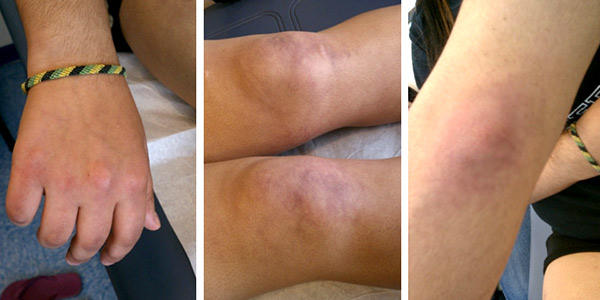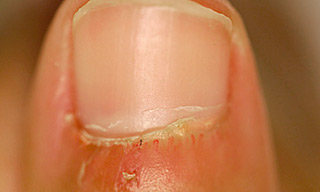An eight-year-old boy presents to your office for an urgent visit for a rash. They have primarily noticed a rash to the child’s hands, knees, and elbows.

A very close look at the child’s fingernail area finds the following:

- What associated symptoms might be expected on review of systems?
- fluctuation of the rash with twice daily fevers
- blue color changes to the hands with cold exposure
- oral ulcers
- new difficulty keeping up with peers in soccer
- What lab tests would be particularly helpful to you in pursuing a diagnosis?
- CBC with diff/plts, ESR, ANA
- amylase/lipase, CMP, ESR
- CPK, AST, ALT, LDH, aldolase
- UA with protein:creatinine ratio, double stranded DNA, ANA
- What are clinical signs of potentially serious complications to be watched for in juvenile dermatomyositis, regardless of therapies?
- change in voice noted by parents
- child’s avoidance of solid foods
- bloody stools
- respiratory distress
- all of the above
-
Question 1
Correct answer: D - New difficulty keeping up with peers in soccer.
The rash pictured is indicative of juvenile dermatomyositis (JDMS). The JDMS rash tends to involve extensor surfaces, including hands, elbows and knees as pictured. When flat these lesions are referred to as Gottron’s sign, when raised they are referred to as Gottron’s papules. While not specific for dermatomyositis, changes to the nailbed capillaries as seen in the close-up picture are classically seen in JDMS. A purple hue to the eyelids is also part of classical JDMS skin changes, referred to as the ‘heliotrope’ rash. The rash of JDMS may bring the child to medical attention before the onset of significant weakness. It is therefore critical to probe for signs of even subtle weakness, such as trouble keeping up with peers in physical activities.
Fluctuation of rash with twice daily fevers would be suggestive of the Still’s rash of systemic juvenile idiopathic arthritis. Blue color changes to the hands with cold exposure may indicate Raynaud’s Phenomenon, which is more likely to be associated with lupus or scleroderma; Raynaud’s is not classically associated with JDMS. Oral ulcers are non-specific, and are not indicative of JDMS.
Question 2
Correct answer: C - CPK, AST, ALT, LDH, aldolase
The rash and description of difficulty keeping up with peers in sports raises concerns of juvenile dermatomyositis (JDMS) or possible another muscle problems. It is helpful to get a panel of muscle enzymes rather than just a CPK, as the CPK may be normal even in the setting of active myositis. The panel of CPK, AST, ALT, LDH and aldolase will give more information regarding possible myositis than the CPK alone.
The other possible answers are not as helpful to screen for muscle disease. Answer A (CBC with diff/plts, ESR and ANA) may provide useful basic information, though all of these parameters could be normal in JDMS. Answer B (amylase/lipase, CMP, ESR) may be helpful in consideration of pancreatitis, though does not screen effectively for muscle disease. Answer C (UA with protein: creatinine ratio, ANA, double stranded DNA) would be more useful to screen for lupus than for muscle disease.
Question 3
Correct answer: E - all of the above
Juvenile dermatomyositis requires constant monitoring of patients, even after immunosuppressive therapies are initiated. A change in voice noticed by family or friends can indicate pharyngeal muscle weakness and a choking risk. Pharyngeal muscle weakness can also manifest as a change in the child’s dietary choices, avoiding solid foods that become hard to swallow. Bloody stools may indicate that a child with JDMS has significant involvement of the GI tract, which poses a risk of perforation. Juvenile dermatomyositis can be associated with pulmonary involvement of the disease itself, which is rare, but a poor prognostic sign.